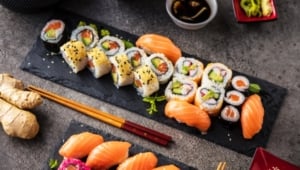Is Sushi Healthy? 6 Benefits, 3 Risks + Checklist

Sushi: is it healthy or is it bad for you? Maki, Nigiri and inside-out rolls – when it comes to sushi, the different types are a dime a dozen. But which of the ingredients are actually healthy? And what are the potential health risks posed by the traditional Japanese cuisine? Read on to find out, as well as to discover our checklist with tips on how to stay healthy when opting for sushi.
Sushi is becoming more and more popular and the tasty food comes in many different shapes and sizes. Some types are low in calories and very healthy, while others contain ingredients that can pose risks to your health when consumed in high quantities.
But what is actually in sushi and where does it come from? What are the healthiest types of sushi and which ones can you eat if you want to lose weight?
Interesting facts about sushi

Interesting facts about sushi
We’re here to tell you everything you need to know about the history of this rice-based dish and get you a little more familiar with the different types of sushi out there.
In addition to learning how many calories are in some kinds of sushi, you will also find out about its health benefits and why it can sometimes be bad for you.
What is sushi?
Sushi is a Japanese dish made with cold vinegared rice as the main ingredient. The rice is rolled in dried Nori seaweed and contains other ingredients, such as raw fish or vegetables. The sushi rolls are then cut into slices. The ingredients vary depending on the type and recipe.
Hosomaki are thin rolls with one to a maximum of two ingredients rolled into half a sheet of Nori. The rolls are cut into six pieces of equal size and height.
Futomaki involves at least three ingredients being wrapped in one whole sheet of Nori, making a thicker roll. Compared to hosomaki, this type of sushi contains less rice, with more space for other ingredients.
California rolls (also called uramaki or inside-out rolls) have the Nori inside the roll rather than on the outside, enclosing the rest of the ingredients. The rice is on the outside and usually topped with some sesame seeds, chives or fish eggs.
The original type, nigiri, refers to a small roll of rice two fingers wide. These sushi rolls are typically topped with fish or omelet.
Temaki is made with a sheet of Nori rolled into a shape that resembles a candy cone and filled with rice and other ingredients.
Sashimi is, strictly speaking, not sushi at all, but can be found on the menu of any sushi restaurant. Sashimi refers to bite-sized pieces of fish served on their own without rice.
Where does sushi come from?

Nigiri was the first type of sushi
Contrary to popular belief, sushi does not originate from China or Japan, but actually from Southeast Asia where they would put fish into cooked rice to preserve it. Originally, the rice was not eaten afterwards.
This method of preserving fish became more and more popular as the years went by and spread to Japan via China.
As living conditions improved, the fish no longer had to be preserved for so long, meaning that it became possible to eat the rice as well. To maintain the sour taste, rice vinegar was added and the rice was also pressed to trigger the fermentation process.
Then, in 18th century Tokyo, sushi evolved into what we know it as today. The name "sushi" was coined back in 1781 by the Kodai Suzume-zushi Sushiman restaurant in what was then Edo (now Tokyo), and you can still buy sushi from this restaurant to this day.
At that time, the rice dish was primarily served as fast food for dock workers and from the 18th century onwards, the Japanese began to incorporate what is now known as nigiri into their diet.
In the 20th century, Japanese emigrants brought this healthy kind of fast food to the entire world and the most popular types of sushi were invented in the mid-20th century.
Did you know…?
Onigiri, a rice ball dish, is actually not a type of sushi. This is a Japanese snack, which, unlike sushi, is made with steamed, lightly salted rice.
The rice is formed into dumpling-like balls, sometimes filled and usually wrapped with Nori. Besides the familiar triangular shape, the rice balls can also be square or round.
Is sushi good for you?

Is sushi good for you?
Many of the typical ingredients in sushi are very healthy and contain valuable vitamins. Below you can find out which of the ingredients are good for you and your health and the reasons why.
We have also put together a selection of light, healthy sushi rolls that are suitable for weight loss diets, as well as some useful information on what to consider if you want to eat sushi and lose weight too.
Basic healthy sushi ingredients
As a basic principle, sushi is made up of fish, rice, and nori sheets. Wasabi, soy sauce and pickled ginger are also classic and very healthy additions to the dish. Below you can find out what makes each ingredient healthy and why.
Raw fish

Raw fish is rich in valuable vitamins
Raw fish contains a number of valuable vitamins, such as various B vitamins. Vitamin D is also an essential component of fish and is often found in salmon and herring. This is fundamental for your bone metabolism – it strengthens your bones and your teeth too.
Vitamin D is also relevant to muscle metabolism and helps fight off infection. It regulates the absorption of calcium and phosphate from the intestine.
Fish also contains vitamin A, which is valuable for our bodies. This is necessary to regulate our physical growth and plays an important role for our eyesight, helping the eyes to distinguish between light and dark and counteracting cell damage. Vitamin A also plays a role in reproduction.
Healthy trace elements, such as iron, phosphorus and iodine, are also to be found in fish. In fact, fish is the only source of iodine worth mentioning, making it crucial for our thyroid function.
Fish is also characterized by its high proportion of omega-3 fatty acids, which are important for our metabolism. Omega 3 also strengthens our cell membranes and thus our immune system. Furthermore, fatty acids counteract inflammatory processes.
We need animal protein for metabolic processes and for building up our body’s own proteins. This is something that fish also gives us and seeing as fish is one of the main ingredients of sushi, this is one reason why sushi can be good for you.
Rice

Rice contains fiber to help digestion
Rice largely consists of carbohydrates and protein, but is also an excellent source of fiber, which has a beneficial effect on digestion.
Vitamin B and minerals such as potassium and magnesium can also be found in rice.
White sushi rice, however, is polished and milled after harvesting, which unfortunately reduces the vitamins and minerals it contains.
Sushi rice is also usually mixed with vinegar, as well as sugar and water. This, of course, makes it unhealthier than regular rice.
Nori

Nori is rich in vitamin B12
Nori is fat-free and thus contains very few calories, which makes it a great food to consume. What’s more, the seaweed sheets are rich in protein and fiber.
In addition, they contain trace elements such as zinc, magnesium, phosphorus, iron, a lot of iodine as well as vitamins A, C and E.
Nori is also characterized by its high vitamin B12 content. Vitamin B12 is especially important for vegans because it is otherwise only found in animal products.
However, only small amounts of the seaweed are used to make sushi, so you can’t expect to gain a large amount of nutrients from the Nori alone.
Only in the sushi triangle "Onigiri" is one whole Nori sheet used, which helps with the absorption of the nutrients present.
Wasabi

Wasabi paste making
Wasabi paste is often used to coat sushi or a garnish. The green paste traditionally tastes spicy as well as sweet.
Wasabi comes from the Brassicaceae, or mustard, family. It is made by rubbing the rhizome on a wooden board covered with shark skin.
This sushi ingredient both facilitates and stabilizes digestion and strengthens the immune system. The plant is also said to have a purifying effect on the liver, as it helps with detoxification.
Wasabi is also called a herbal antibiotic because it contains the mustard oils glucocochlearin and sinigrin. These pungent oils can inhibit the growth of harmful bacteria in the body and even sometimes kill them.
What’s more, the oils fight pathogens such as fungi or viruses and are particularly effective for upper respiratory and urinary tract infections.
Top tip: unfortunately, most wasabi pastes you can buy in stores usually contain less than 5 percent wasabi. They often contain a mixture of horseradish, mustard flour, corn or potato starch and artificial coloring. Therefore, it’s a good idea to take a close look at the product’s ingredient label before making your purchase.
In general: the more actual wasabi there is in the product, the healthier it will be.
Pickled ginger

Pickled ginger is a popular sushi garnish
Gari is a popular garnish for sushi, otherwise known as pickled ginger. In principle, gari does the same thing as fresh ginger, but sugar is added during the pickling process, which is why we only recommend eating it in moderation.
Ginger has been used for remedial purposes in East Asia for thousands of years. The root is effective against nausea, which is why it comes in handy if you suffer from travel sickness.
This sushi garish also helps with your digestion, namely with flatulence, constipation and cramps, and it boosts bile production, which makes it especially beneficial after eating fatty sushi.
This "miracle root" also strengthens your immune system and helps fight off viruses as well as colds by loosening mucus.
It should be noted, however, that pregnant women are advised against eating ginger.
Soy sauce

Soy sauce contains hardly any calories
Sushi is traditionally served with soy sauce. The small rolls are perfect for dipping in the sauce to give them an additional kick.
It traditionally takes at least six months to produce, and sometimes even up to two years. Soy sauce brewed according to the traditional Japanese recipe only contains the following ingredients: soybeans, wheat, water and salt.
What’s more, the brown-colored sauce does not contain any fat, and therefore has very few calories, and dark soy sauce contains a lot of protein and valuable amino acids.
Traditionally, the sauce also contains a lot of antioxidants, but unfortunately these are usually lacking from industrially produced sauces because the maturing process is skipped during bulk production and wheat is omitted completely. Instead, these products contain additives, such as glutamate or preservatives.
Therefore, soy sauce that has been brewed in a traditional production process is definitely better for you in terms of health.
Top tip: you should pay attention to the recipe when choosing your soy sauce. Sauces made according to the Japanese recipe are not chemically produced. Likewise, most organic soy sauces are made in line with traditional standards and not genetically engineered.
Healthy vegetable fillings

Healthy vegetable fillings for sushi
In addition to the traditional fish filling, sushi can also be prepared with a wide variety of vegetables, meaning that the popular Japanese dish can also be integrated into a vegetarian or vegan diet nowadays.
What’s more, types of sushi without fish are becoming increasingly popular among pregnant women, who should generally avoid eating raw fish.
The classic among vegetable sushi is definitely kappamaki, which is maki with cucumber. Superfoods such as avocado are also popular ingredients in various types of sushi.
Futomaki can also be filled with things such as Japanese mushrooms, peppers or carrots. Fresh vegetables like carrots contain a lot of vitamin A and beta-carotene, which is beneficial for your skin and eyes. Tofu is also a popular sushi filling, especially among vegans.
Generally speaking, sushi can be made with anything that tastes good, and if you make it yourself, you can choose whichever filling takes your fancy, decide how healthy or unhealthy you want it and how many calories it contains too.
How many calories does sushi contain?
It’s hard to say exactly how many calories sushi contains, just as it’s hard to make a general statement on whether sushi is healthy or not. The amount of calories in sushi can greatly vary from one restaurant to the next.
The amount of calories depends on the size of the sushi, but above all, on the individual ingredients of each sushi dish. Nevertheless, we have summarized the average values of some standard types of sushi in this table:
| Sushi type | Calories per piece (approx.) |
|---|---|
| Kappamaki (cucumber) | 20-25 kcal |
| Nigiri (salmon) | 50 kcal |
| California roll | 50-55 kcal |
| Sushi box of nigiri & maki (without fried ingredients) | 400-450 kcal |
Generally speaking, the more rice the sushi contains, the more calories it will have. The sushi varieties with the lowest calories are maki and nigiri, mainly because they contain little rice. As a low-fat, healthy and yet filling meal, we recommend two to four nigiri and six maki.
Is sushi good for losing weight?

Is sushi good for losing weight?
As with any other diet, if you want to lose weight, it depends on what’s in your food. If you make your own sushi, you can decide how healthy it is and whether it fits with your diet or not.
If you’re ordering sushi in a restaurant or buying it from a store, however, there are a few things you need to look out for to find the sushi that will help you stick to your diet.
There are studies that show that a combination of protein with resistant starch, as is the case in sushi containing fish, helps you burn more fat and feel full too. It’s also worth bearing in mind that sushi containing fish is more likely to be beneficial to weight loss if the fish is raw and not cooked.
Try and opt for brown rather than white rice in your sushi too. Your body will get more fiber this way and you will feel fuller faster and for longer.
You can also ask if it’s possible to have your sushi cut into eight rolls instead of six.
This way, you’ll feel like you’ve eaten more sushi than usual, but you won’t consume any extra calories.
If you want to lose weight but keep eating sushi, you should avoid fried sushi, fatty sauces like mayo and bread coatings, such as sushi with tempura or crunchy rolls, as they contain lots of fat and carbs. Stick with soy sauce and say no to sesame oil and eel sauce for the same reason.
All in all, we cannot make a blanket statement on whether sushi is healthy and good for weight loss, but we can give you some advice on what types to go for and what to avoid. Read on to find out what kind of sushi you should order at a restaurant if you’re trying to lose weight.
Please still keep in mind, however, that losing weight is always about maintaining a balance between eating healthily and getting enough exercise.
Healthy sushi rolls

Light, healthy sushi rolls
Ordering sushi is tricky business: if you don’t order the right kind, your sushi could be a real calorie bomb, and so to avoid this happening, you should choose one of the following light and healthy sushi rolls.
- Tuna roll
This is the simplest kind of sushi roll and works super well as a quick, healthy snack. With six to eight pieces of tuna roll, your body will get around 3.5 grams of fiber and 24 grams of protein. This protein is also the origin of more than half the calories, which amount to only 184 with this many tuna rolls. - Avocado roll
You can’t go wrong with this healthy sushi option, as six to eight rolls contain 3.5 grams of fiber and six grams of protein at just 136 calories. What’s more, it is vegetarian, so it is suitable for those who don’t eat fish or meat. - California roll
Yes, also the popular California roll is a great healthy option that you can eat if you want to lose weight. You should ask whether it contains real crab so you can get even more protein. The typical six to eight California rolls contain about 6 grams of fiber, 9 grams of protein and 255 calories.
The healthiest sushi rolls are those that contain lots of protein, little rice or brown rice and no sauce at all.
Health risks: is sushi bad for you?
Although the individual ingredients in sushi have many health benefits, we would also like to highlight some of the potential risks and answer the question of whether sushi can actually be bad for you.
Raw fish contains bacteria

Raw fish may contain bacteria or heavy metals
In certain circumstances, raw fish can be harmful and even transmit parasites. There are a few known cases in which anisakid nematodes were transmitted to humans by raw fish.
People infected with anisakiasis, otherwise known as herring worm disease, complained of nausea, vomiting and severe abdominal pain. In the worst case scenario, the disease can even cause intestinal perforation.
For pregnant women and small children, or people with weak immune systems, raw fish comes with another health risk: it may contain listeria, which can trigger a potentially life-threatening infection, especially in unborn babies.
For those at risk, however, there are many vegetarian and vegan sushi options that do not contain raw fish.
Mercury in tuna
It is increasingly the case that alarming levels of the heavy metal mercury are being found in tuna fished from the Pacific Ocean. Scientists in the USA found astonishingly high concentrations of it in the tuna used in sushi.
Mercury is a neurotoxin that is particularly harmful to children. Symptoms of excessive intake include trembling, nervousness, personality changes, and deterioration of short-term memory.
The toxin enters the fish’s habitat through volcanic rocks or sewage, for example, but also as a result of the burning of fossil fuels. The fish absorb the pollutants, which then accumulate in their tissue.
Heavy metals in Nori

Nori may contain heavy metals
Some types of seaweed also have the tendency to absorb pollutants such as heavy metals.
Toxic heavy metals, such as cadmium, lead, arsenic and aluminum, in particular, have been shown to appear in high concentrations and one in ten samples of seaweed tested exceeded the maximum value permitted for cadmium.
In addition, three quarters of all seaweed samples contained too much iodine. Iodine is essential for our thyroid function, but when consumed in excessive amounts, it can be harmful to the thyroid gland.
However, as such little Nori seaweed is used to make sushi, the pollutant content is harmless.
Nevertheless, you should still refrain from consuming too much sushi.
Top tip: to avoid consuming too much iodine, we recommend purchasing products that clearly indicate how much iodine they contain.
Healthy sushi – a checklist
Here is a checklist to help you enjoy your sushi whilst staying healthy.
- Opt for nigiri, maki or sashimi
- Eat a mix of fish and vegetable sushi to benefit from both
- Do not eat sushi that contains fatty sauces such as mayonnaise
- Avoid sushi that is too sweet
- Leave out tuna due to the health risks (at least abroad)
- Eat enough wasabi and ginger with your sushi
- Stay away from fried sushi
- Don’t eat too much (usually two to three kinds of sushi are enough)
- Eat with chopsticks – this will help you eat more slowly and get full faster
Make your own healthy sushi rolls
Making your own healthy sushi rolls is not only relatively easy to do, but also fun. By opting for wholegrain rice or millet, you can save on the calories in white rice and get your fill of healthy vitamins at the same time.





